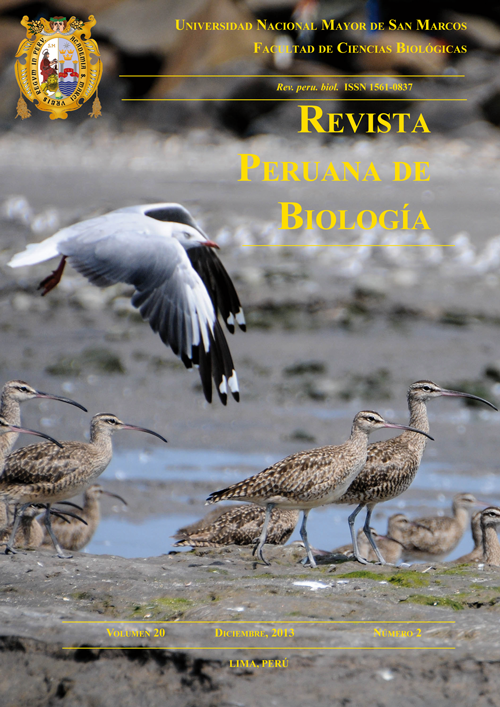La detección de Bartonellaspp. y Rickettsiaspp. en pulgas, garrapatas y piojos recolectados en las zonas rurales de Perú
DOI:
https://doi.org/10.15381/rpb.v20i2.2681Palabras clave:
Bartonella, Rickettsia, arthropods, PCR detección, Perú.Resumen
La Bartonellosis y la Rickettsiosis son enfermedades comúnmente reportadas en Perú. Con el propósito de detectar Bartonellasp. y Rickettsiasp. especímenes de pulgas, garrapatas y piojos de cinco localidades del Perú (Marizagua, Cajaruro, Jamalca, Lonya Grande and El Milagro) fueron colectadas y analizadas. Para la detección se usó PCR y una posterior confirmación con secuenciamiento de DNA. Los especímenes colectados fueron agrupados en 102 pools(76 Ctenocephalides felis, dos Ctenocephalides canis, 16 Pulex irritans, cinco Pediculus humanus, dos Rhiphicephalus sanguineus, y un Boophilus spp.). Bartonellafue detectada en 17 pools(seis de C. felis, nueve de P. irritans, uno de C. canis, y uno de P. humanus). Rickettsiafue detectada en 76 pools(62 de C. felis, 10 de P. irritans, dos de P. humanus, y dos de C. canis). Bartonella clarridgeiaefue detectada en C. felis (5.3% especímenes), C. canis(50%) y P. irritans(12.5%). Bartonella rochalimaefue detectada en C. felis(1.3%) y P. irritans(12.5%). Además, se detectó B. henselaeen C. felis(1.3%) y P. humanus(20%). Bartonellaspp. también se encontró en P. irritans(31,3%). Además, se detectó R. felisen C. felis (76.3%), C. canis(100%) y P. irritans(37.5%), y Rickettsiaspp. se detectó en C. felis (5,3%), P. irritans(25%) y P. humanus(40%). Estos resultados demuestran la circulación de estas bacterias en el Perú.Descargas
Descargas
Publicado
Número
Sección
Licencia
Derechos de autor 2013 Abraham G. Cáceres, Carlos P. Padilla Rojas, Javier Arias Stella, Gerardo Huatuco Crisanto, Antero Gonzales Pérez

Esta obra está bajo una licencia internacional Creative Commons Atribución-NoComercial-CompartirIgual 4.0.
LOS AUTORES RETIENEN SUS DERECHOS:
a. Los autores retienen sus derechos de marca y patente, y también sobre cualquier proceso o procedimiento descrito en el artículo.
b. Los autores retienen el derecho de compartir, copiar, distribuir, ejecutar y comunicar públicamente el artículo publicado en la Revista Peruana de Biología (por ejemplo, colocarlo en un repositorio institucional o publicarlo en un libro), con un reconocimiento de su publicación inicial en la Revista Peruana de Biología.
c. Los autores retienen el derecho a hacer una posterior publicación de su trabajo, de utilizar el artículo o cualquier parte de aquel (por ejemplo: una compilación de sus trabajos, notas para conferencias, tesis, o para un libro), siempre que indiquen su publicación inicial en la Revista Peruana de Biología (autores del trabajo, revista, volumen, número y fecha).






